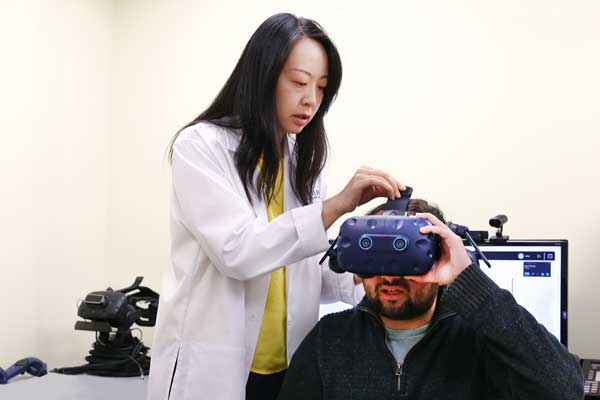Exploring a New Dimension: How Virtual Reality Aids Rehabilitation in People with Disabilities
Virtual Reality Day 2023
By Diana Jordan, Assistant Digital Media Editor, Media/Communications Department

reality headset on a participant.
Imagine a simulated, three-dimensional (3D) environment that you can interact with but turn on and off as you please. Is that even possible? The answer is yes, and it’s called virtual reality (VR). When you think of VR, the first thing that may pop into your head is its use in video game simulation, a great example of non-immersive VR used in everyday life.
Semi-immersive VR integrates 3D graphics, making you feel as though you are part of an altered reality, yet still feel connected to your physical surroundings. This type of VR is mainly used for educational or training purposes, like a flight simulator.
Fully-immersive VR involves a specialized headset or glasses that provide you with a high-resolution display to make it feel like you are completely immersed in a simulated, 3D environment. At Kessler Foundation, fully-immersive VR is used for studies in stroke, multiple sclerosis, and traumatic brain injury (TBI).
The stroke research team is designing and developing a computer-based treatment software called Kessler Foundation Spatial Retraining Therapy (KF-SRT®) using VR technology to help improve spatial neglect in people who have experienced stroke. This intervention has been used in various clinical settings and at home.
For individuals with TBI, researchers are conducting a study applying VR-based treadmill training to test its effectiveness on walking ability. Researchers are also examining changes in thinking ability and brain activity as a result of VR-based treadmill training.
In the Foundation’s multiple sclerosis research, VR has been introduced to complement traditional cognitive rehabilitation and exercise training. VR may help improve everyday function by increasing sensory input and promoting multisensory integration and processing.
Fortunately for individuals with disabilities, VR has become an impactful tool for rehabilitation. The Foundation is doing much more clinical research to explore its long-term effectiveness.
Watch the VR headset in action.
Listen to a podcast where VR is used in an MS intervention.
Learn more about our research on physical and cognitive disabilities.
